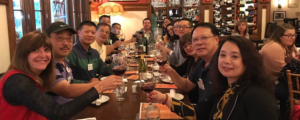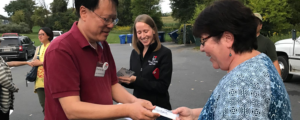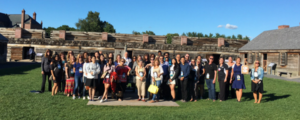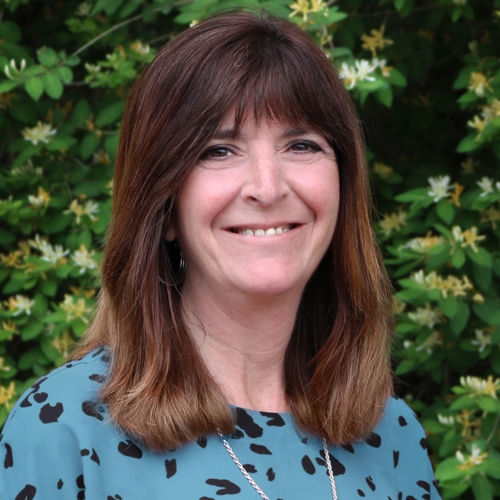Rhonda Vaccaro
Episode 95: How to Create Successful FIT Itineraries for Overseas Visitors, with Rhonda Vaccaro
Today’s podcast is a little different from our regular episodes. We are talking to one of the Break the Ice Media team members on another team-cast episode, Rhonda Vaccaro. We are going to dive into a topic that is a favorite of Rhonda’s- creating successful FIT itineraries.
Rhonda is a Vice President and Senior Consultant at Break the Ice Media. She brings more than 20 years of sales and new business development to her role at Break the Ice. She’s a master at creating relationships and has a deep understanding of sales strategies, creating win-win opportunities for BTI’s tourism clients. Rhonda assists our DMO clients with travel trade marketing strategies, product development, sales outreach, trade show representation, getting products in catalogs and on the shelf, with tour operators, receptive operators, and other trade companies. She also provides tracking and reporting and of course, closing sales successfully. Rhonda currently holds several volunteer positions within the industry. She serves on ABA’s 2018 Marketplace Education Committee, I Love New York’s China Ready Committee, the New York State Tourism Industry Association’s Empire State Tourism Conference Scholarship Committee, I Love New York’s Canadian Roadshow Committee and a co-chair of the Professional Women of the Finger Lakes’ Women of Distinction Awards Committee. Rhonda is 2005 past chairperson of the Visitor Industry Council and a former Digital Rochester board member, where she was the director of major events.
FIT Itineraries
Rhonda, thank you for joining me.
Thanks for having me, Nicole. Always so happy to be here.
I really love the opportunity to share Break the Ice Media’s learnings and everything we know and understand about the travel and tourism industry. I’m really excited about today’s conversation and for our listeners to learn from you, a little bit about what you do and your day-to-day life here at Break the Ice, but also to learn from you and how they can start thinking about and creating FIT itineraries on their own.
Before we get started, I think it’s important that we define FIT for our listeners. Many of them might already know what FIT means and others might kind of know, so I think it’s important to clarify before we dive in. Can you give us a definition of FIT and frame up this conversation?
Sure. FIT stands for “Foreign Independent Traveler.” These are families or small groups of international tourists. They come to the United States and they’re looking for different experiences, but they’re doing it on their own. They may be buying certain vouchers and admission tickets online where they live to our attractions and various accommodations. They come here obviously by plane and they typically will rent cars and they head out on their own. So this is not the group traveler. The FIT traveler is going to do something a little bit more on their own and they’re looking for suggestions and ideas of different experiences and things to do and places to go.
I think that that’s an important point of differentiation in that they are traveling independently. Although they might not be buying a seat on that bus or part of a group itinerary, they still do rely on their travel trade partners to advise them. Isn’t that correct?
Very much so. That’s why it’s so important that we do provide these itineraries or products that these folks overseas can actually see and learn about and buy as a whole because, of course, if we’re traveling overseas, we don’t know always where we want to go or what to do or what the really cool local places to go and see. We’d go to someone that we trust, someone that works in that area and ask them for ideas. It’s very important that we have ideas available for them to see and learn about. Then, they can make their decisions independently as to what they’d like to do and see.

[bctt tweet=”“It’s very important that we have itineraries and ideas available for international folks to see and learn about so they can make their decisions independently as to what they’d like to do and see.” – Rhonda Vaccaro #podcast”]
I would imagine too that when you’re traveling overseas, there might be concerns about language barriers or how welcoming a place might be. Do you see a role for that as well in these itineraries and how effective they can be?
That’s a great point because it’s really important when DMOs or anyone in the tourism industry are putting together these types of itineraries that they do have some education about the international traveler, what type of things that they’re interested in, what type of language is their native language, who are they trying to reach, so when these individuals come to their locations, they are welcomed as they’re accustomed to being welcomed.
Education about the attractions and the accommodations that are included on the itineraries is a must because that’s one thing that they’re going to count on. Say someone from Germany wants to come to New York, they’re going to want to know that the places they visit will welcome a German visitor. Education is really important. Industry leaders need to curate these itineraries with the right travel partners in place who will understand and welcome international visitors. Then, there’s typically contracts that are signed with international travel professionals to be included in these itineraries.

[bctt tweet=”“Industry leaders need to curate these itineraries with the right travel partners in place who will understand and welcome international visitors.” – Rhonda Vaccaro #podcast”]
Itinerary 101
I think what that illustrates is that you don’t just dive right in and jump right to the itinerary. Things need to happen behind the scenes before you jump in. I also know that you’ve got some really great pointers in terms of creating a FIT itinerary and I’m wondering if you can walk our listeners through some of those.
Sure. As far as starting a FIT itinerary, it’s nothing that just happens. To even create the itinerary appropriately, you’re probably looking at least a six month to a year window to gather all the information and to have the education and to have something that’s a solid product that you can sell overseas. It’s really important to understand these things take time.
Then, once they are developed, they continually evolve. As we learn more about the travelers who use these itineraries, and as more attractions and accommodations become familiar with this whole idea, the itinerary will evolve over time. It’s not a one-and-done thing at all, but it’s important to have a starting point.
When you’re starting with a FIT itinerary, as you would with anything, you would want to give it an interesting and enticing title. What is the theme of the itinerary? That will speak to certain types of travelers. One might be outdoor adventure. That’s going to obviously speak more to people who are interested in the outdoor experiences. One could be water and wine, focused on experiences maybe with boat cruises and different type of culinary things. It really is depending on who you want to reach, but that one opening statement is going to get someone’s interest to read more.
After you do that, you’re going to think about logically what makes sense for a traveler. When we make itineraries, want to include as many of our assets as possible, all of the local treasures. But you have to understand that people can only do so much in a day. While these are suggestions, make sure it’s placed in logical sense for someone who is traveling.
For example, if someone is traveling, they come into New York City, spend some time there and then they want to drive across the state and end up in Niagara Falls. You would start with, the first thing on your itinerary is going to be the closest thing to New York City, and then move accordingly throughout the state, but when you’re doing that, remember that these folks are independent travelers. There is no bus full of other people that have to keep on a schedule. These are completely open days that they’re filling. You don’t want to tell them that they’re going to be someplace for an hour and a half. You’re going to give them suggestions as to places you can go to and the experiences that can be had there. You’re not going to put specific time specifications around that.
Of course, these itineraries are not just used as printed pieces of collateral or in advertisements, but they’re also shared digitally and online. In either case, visuals are a must. You really want to provide some enticing photos. More often than not, we’re finding that photos of people having an experience, doing something at the location is a little bit more useful than just a picture of the location. It makes it a little bit more relatable to people when they’re looking at and seeing what other people are actually doing.
Then, of course, with a picture, you need a description. Remember, these people don’t know anything about the area, so you want to talk about the activities and the sites that they’re going to see there. But you don’t want to take up too much time or space because you don’t want them to lose interest. The descriptions should be experiential. They should talk about what you could expect when you’re there because we all know that today’s tourist really seems to be looking at those experiences as a much more of a decision-making factor versus just sightseeing and historical opportunities.
Know who you’re talking to. That goes back to the education that we talked about earlier. Know your audience. Who are you trying to attract? It’s not just what country they come from. It’s also about demographics. For FIT, you want to have family-friendly things offered on your itineraries because often times, these will be families, but you also want to have things that might be adult-orientated for groups, a couple who wants to take a vacation just the two of them or a girlfriend getaway or something like that. Know who your audience is and speak to that audience.

[bctt tweet=”“Know who your audience is and speak to that audience.” – Rhonda Vaccaro #podcast”]
Less is more. As I said, you want to have your descriptions, but you’re not going to include things on an international itinerary such as telephone numbers and hours of operations and things like that. You are going to include websites so they can go online and they can check it out for themselves and if you feel it’s needed, then a contact name, but that’s the only information you’re really going to include on an itinerary. Again, this is a suggestion. Then, the travel trade professional that they’re working with can help them actually make arrangements to either purchase tickets or reserve a spot.
Then, you want to show them exactly where they are. Every itinerary should include some type of a map. It does not need to be detailed. You actually don’t want it to be a detailed map, but back on the example of say, someone traveling from New York City to Niagara Falls, and you want them to stop along the way depending on who you’re showcasing in your itineraries. You want to put little identifiers on a map. “This is New York City”, and you could even say, “A hundred miles to this destination and a hundred miles to the next destination”, so they have some idea of what they’re actually traveling.
You want it to look very professionally done. Again, these are people who don’t you, don’t know our area. Other travel professionals are only going to want to showcase your itinerary if it looks like it’s professionally done because it reflects on them. It has to really look really nice and it’s worth the investment of a professional designer to ensure the quality of the piece.
Nicole, you know where we live. We live in an awesome state. We have these two incredibly fantastic tourism destinations on each end of our state. We’ve got New York City that is a natural gateway for international tourists, one of the largest in the world. Then, you have Niagara Falls, which is also one of the largest. They’re coming here. The rest of us in the state have to let them know what else there is to do and see here because as we know, there is a lot to do and see here.
Yeah. I completely agree. I think these were really great rules of thumb or best practices that you just shared with our listeners. Everything from making sure that you start with an interesting title, that attention grabber, making sure that you’re using images, concise descriptions all the way down to make sure it’s professionally designed.
A couple of other things that I wanted to make sure listeners picked up on is that this is an ongoing process. It’s not that you get to the end and you have your one itinerary and you’re done. It’s something that’s living and breathing and that you’re constantly going to look at and to tweak.
Once you get the itinerary completed, what are some different things that one might do with it? How do they get into the hands of these international visitors?
Once they have an itinerary completed – which is a huge feat in and of itself and it’s a great accomplishment – once that’s done, it’s all about relationships. It comes down to the relationships that you have with receptive operators. Receptive operators are also known as “inbound operators”. They work with travel trade professionals in the various countries outside of the United States, whether it be a tour operator or a travel agent to have these itineraries.
You’re going to start with and they actually refer to it as a “product”. There’s an itinerary, for example, that I’ve done when I worked with Syracuse. It’s called “The Nine Days in New York State Itinerary.” That itinerary includes the Hudson Valley, three days there, three days in Syracuse and then three days in Buffalo. That itinerary is a product. Through relationships with different receptive operators, they are actually promoting that itinerary on their own websites and in their own catalogs. You have to start working with them and you also have to create relationships and agreements with the attractions, with the stakeholders on the itinerary and the accommodations on the itinerary with these receptive operators so they can then sell the experience, the attraction, the ticket, the overnights for the individual across seas. You could start working with a receptive operator who will then work with other travel trade professionals.
Relationships are Key
You know what I’m hearing from all of this is something that we love to talk about on this podcast: collaboration. It takes collaboration with those attractions and accommodations that are being featured on the itinerary, collaboration with those receptive operators, trying to help them understand your product so that they’re able to sell it. Then, I think you also alluded a little bit to collaboration between destinations. I’m wondering if you can elaborate on that a little bit. You mentioned this Nine Days in New York Itinerary that takes a travel from New York City to Niagara Falls or back and the three destinations in between that have collaborated on that particular itinerary. Can you share a little bit more about how that came about?
Yes, I can. One of the coolest things we get to do in our business is working with our other tourism partners to create something that is so much bigger and better than any one component.

[bctt tweet=”“One of the coolest things we get to do in our business is working with our other tourism partners to create something that is so much bigger and better than any one component.” – Rhonda Vaccaro #podcast #WhyCollaborate”]
In this case, there were three tourism offices. I represented Syracuse and then Duchess County in the Hudson Valley as well as Buffalo and Erie County. We all got together and worked collaboratively and still do to create an itinerary. It started with me asking them to give me three days and tell me what it is that you think is good to do, that you want to include from the Hudson Valley and then move on to Syracuse and then move on to Buffalo.
Then, the thing that’s really cool about it is that there are three separate entities that are promoting this itinerary. Someone from Buffalo, Leah Mueller, who I believe has been on your podcast, say she goes to an international travel show. She is promoting that itinerary. I represent Syracuse. I was not at that show, but that’s okay because that itinerary is being represented anyway. The same thing what happened with Don from the Hudson Valley in Duchess County.
When other collaborative partners are out there building their relationships, everyone benefits. It’s such a strong collaboration when you get together and you look at it and then the, in this case, three entities can decide how they want to change it or massage it or add to it as new relationships are formed with receptive operators. That’s how that works and it’s certainly not a one-and-done deal. It’s a continuous evolvement of opportunities through these three separate entities.

[bctt tweet=”“When other collaborative partners are out there building their relationships, everyone benefits.” – Rhonda Vaccaro #podcast #WhyCollaborate”]
Yeah. I love that too because you are able to cross-promote each other that way. Tourism budgets can be tight in counties and it’s always challenging to figure out where to best spend your money, but I can see where you can really maximize budgets by working together in this way, getting representation of your product or your itinerary in multiple shows that you may or may not be participating in.
There is also a whole extra level of marketing, and that those three counties had put some thought and time into doing some cooperative marketing. Can you expand on that a little bit too?
One thing for sure is, even with our own state tourism agency, I Love New York, along with the three tourism offices work together to share it. I Love New York does promote the entire state, but they can take this itinerary and then cover three separate counties across the entire state. It’s one product that we can share with own state tours and department to promote that way and to bring tours into our country, into our state and country, that are going to benefit from this itinerary. We also promote in overseas publications. One of them is called “Travel Biz”, and in primarily UK. It’s not inexpensive to have an ad in this publication that’s being shared with consumers and other travel professionals overseas. The three entities together share the cost of, in this case, we did a full page ad. It could’ve maybe had been a quarter page ad individually for the same money, but since we were able to collaborate, each putting in that same amount of money, we now can be exposed on a full page ad. That’s just in one travel trade publication.
Then, we also work with the various receptive operators to advertise in their own catalogs. Together, as I mentioned, advertising is not inexpensive and when you have three budgets and each takes a third of it, it’s a much more doable and cost-effective way to market a region and itinerary.
That sounds like a win-win-win to me.
As I knew this would be a very interesting conversation, and that you’d have a lot of great insight to share with our listeners. This has been just that. Before we say goodbye, I’m wondering if you have any final words of wisdom that you’d like to pass on to our listeners.
Yes, I would.
I really want to share with people and to provide information about how cool this opportunity really is. For the people involved in FIT itineraries, anything overseas, the other travel trade professionals that are promoting it are doing it really at no cost. There is no cost to anyone to be a part of the itinerary unless something is sold. Then, of course, there is a commission or a net rate paid to the receptive operator who is actually in the travel agent overseas, but these are opportunities that wouldn’t have been had otherwise. You’re working with other people who want to sell your product because that’s how they make their money, and it’s not going to cost anything unless a sale is made. Then, that’s just part of marketing. It’s really important to remember that.
What’s happening here is just a win-win for everybody, and because they’re selling overseas, they’re selling at times where we may not be getting our holiday traffic. It could be any time of year and it’s not just the weekends. It could be during the week. For accommodations that get concerned about what they have to commit to, you can actually blackout dates. If it works certain times during the year and it doesn’t work other times, that’s okay. People really can be open to a whole new influx of business if they’re just included in these itineraries. I strongly suggest learning more about it. Of course, we’re always happy to share ideas here at Break the Ice Media.
That is an awesome way to end. I’m actually hearing perhaps we’re going to need to have another team cast to talk a little bit more deeply about pricing and contracts and how all of that works because I know it’s very complex and you do have a lot of experience in that. We will look forward to having you back on a future team cast to share more of your knowledge.
Thanks, Nicole. I’ll look forward to it.
We value your thoughts and feedback and would love to hear from you. Leave us a review on your favorite streaming platform to let us know what you want to hear more of. Here is a quick tutorial on how to leave us a rating and review on iTunes!







